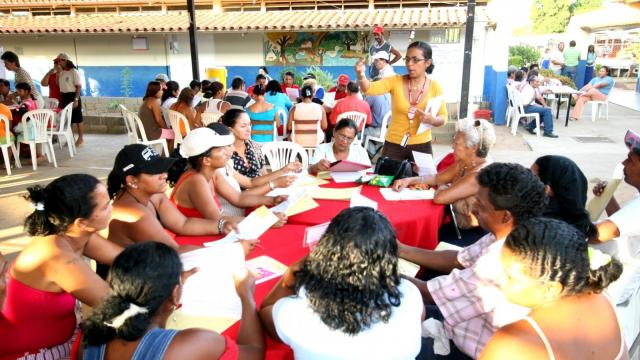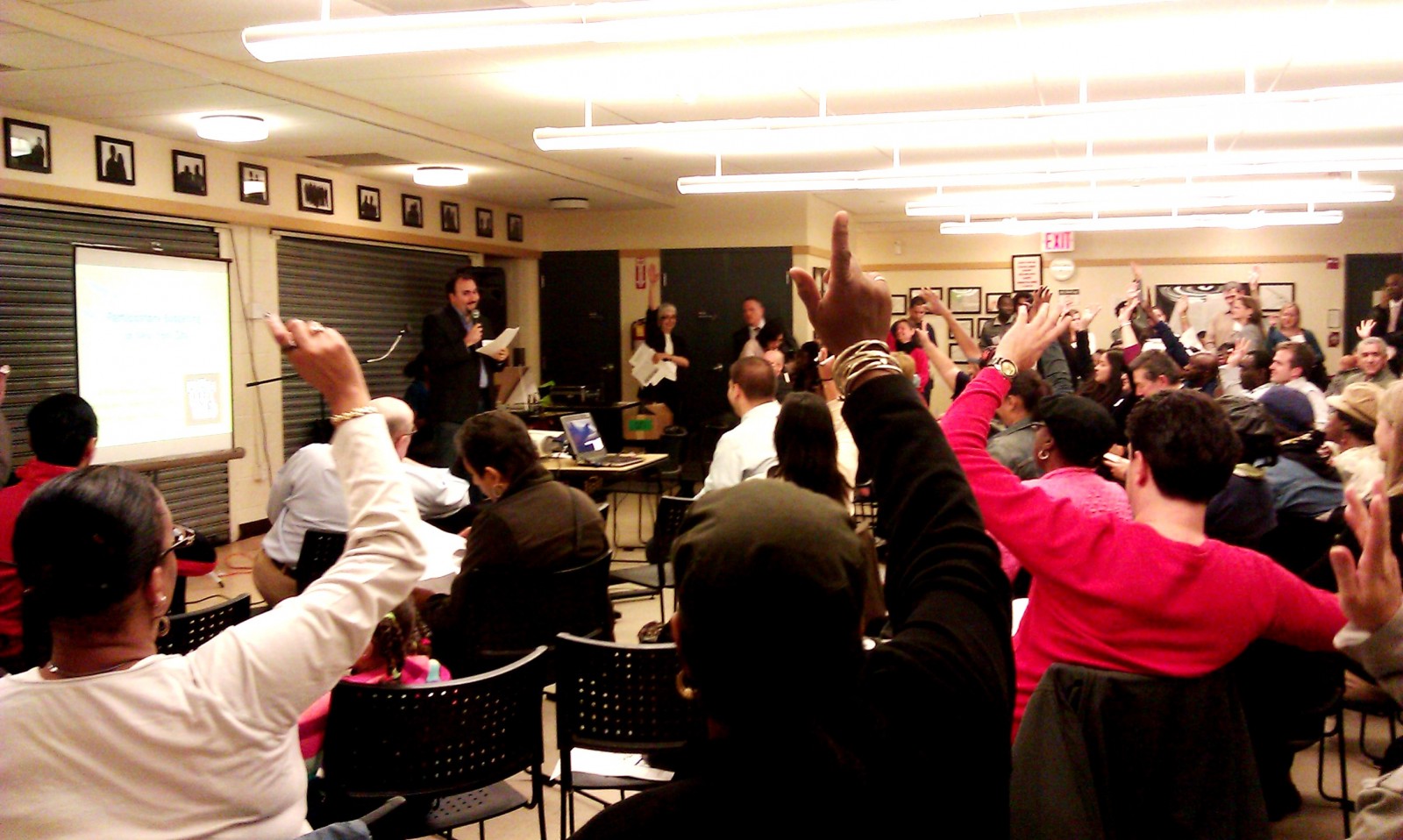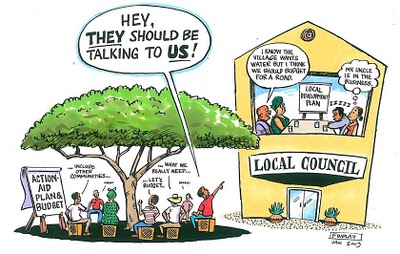
Over the next month, thousands of residents in New York, Chicago and the Bay Area are going to the polls—but they won’t be putting anyone in office. Through a civic reform called participatory budgeting, they’ll be deciding how nearly $20 million of tax dollars are allocated.
Participatory budgeting (PB) transfers decision-making power from elected officials to everyday people, but it’s not simply a Swiss- or California-style referendum applied to budgeting; rather, it’s an annual, year-long process marked by community engagement and deliberation.
A typical PB cycle begins with a series of public assemblies where residents discuss and identify needs in their neighborhoods. Community members then meet over several months to scrutinize the ideas and develop them into concrete funding proposals. At the conclusion of the cycle, the proposals are voted on by the entire community and the winning projects are funded and implemented.
“Not only does PB let regular folks decide how to spend public money—it also gives them the time to make informed decisions that best address the needs of the community,” said Josh Lerner, executive director of the Participatory Budgeting Project, a non-profit that works with cities and organizations to implement PB.
The potential to empower communities to make collaborative decisions is what recently brought PB to Vallejo, California, a Bay Area city of about 117,000 which, in 2008, became the largest city in California to declare bankruptcy. Now returning to fiscal stability, the city is engaging the public in a PB process that aims to improve decision-making and model a more democratic form of local governance.
The first cycle of PB Vallejo concludes this May, when Vallejo residents will decide how to allocate over $3 million, about one-third of revenue raised this year through a one-percent sales tax. Vallejo resident and PB participant Jessy Zapanta Chua said that she is already seeing changes in her community.
“We're talking to our neighbors, we're connecting to accomplish common goals, we're realizing that we have the power to make improvements to a city that for years has only been known for its crime and poor economy,” she said.
Vallejo is the first U.S. city to adopt PB at a city-wide level. In the three other cities—Chicago, New York and San Francisco—a growing number of wards and council districts are undertaking PB with discretionary funds available to their respective aldermen and council members.
Deeper Democracy, from Brazil to the World
Although new to the U.S., PB has developed around the world for over two decades. This model of budgeting originated in the city of Porto Alegre, Brazil, where, in 1989, a newly-elected Workers’ Party agreed to the demands of local social movements and began to open up the city’s budget to popular control.
Adopted as a means to make municipal spending more equitable and transparent, PB was a central part of administrative reforms that led to dramatic changes within a decade: access to sewage and water systems increased from 75% of households to 98%; the number of schools quadrupled; and health and education expenditures jumped from 13% to almost 40% of the annual budget.
According to Gianpaolo Baiocchi, a sociologist at Brown University who has studied PB in Brazil, the impact of PB on the city’s civic culture was equally transformative: PB became a core aspect of community life, the activity of civic organizations grew significantly, and tens of thousands of residents—the majority from working-class and poor, slum neighborhoods—participated annually.
Inspired by the success of PB in Porto Alegre, cities across Brazil followed suit—and soon participatory budgets began to appear in Europe, Africa and Asia. By most estimates, there are now around 1,500 participatory budgeting processes around the world, and more than a few notable cases among them.
In Torres, Venezuela (population 190,000), residents use PB to control 100% of investment expenditures. In Belo Horizonte, Brazil (population 2.5 million), residents have had the power to allocate half of the city’s investment budget, or upwards of $60 million annually. While most participatory budgets are implemented by municipalities, PB has also been used by counties, states, housing authorities, schools, and other institutions
In one of the cuter instances of PB, students in kindergarten through seventh grade at West Vancouver’s Ridgeview Elementary have used PB to allocate part of their Parent Advisory Council’s budget.
PB Arrives in the U.S.
After being successfully adopted in Toronto, Montreal, and Guelph, Canada, PB finally crossed the border in 2009 when Chicago alderman Joe Moore charged the 58,000 residents of his ward with deciding how to allocate $1.3 million of his discretionary funds. To design and guide the process, he looked to Baiocchi and to Lerner (who was involved at the time with a PB process in Toronto’s public housing authority). Both were eager to see what impact PB could have in the U.S., and in Chicago’s 49th ward they found a promising opportunity.
“For me, PB seemed to be a tool to promote social justice and real connection to the machinery of government, two things that we badly lack in the U.S.,” said Baiocchi. “When Joe Moore offered us the possibility of working with his community it was exciting to try to see how much traction we could get on those two things. For a long time, PB in the U.S. had seemed more in the realm of science fiction.”
To support the PB process in Chicago and advocate further for PB, Baiocchi and Lerner established The Participatory Budgeting Project (PBP), a non-profit organization that works to develop and support PB processes in North America. After two successful years in Chicago, PBP began working with four Council Members in New York City who wanted to bring PB to their districts.
In the inaugural 2011 to 2012 PB New York City process (PB-NYC), around 2,000 people across the four districts attended the initial PB assemblies and nearly 6,000 voted on the allocation of $5.6 million in discretionary funds. Both PB Chicago and PBNYC expanded to additional districts this past year.
Whether participation rates will continue to increase is one question; whether PB will radically transform the way communities govern themselves is another. Neither question, however, will be answered quite yet. Those with international perspective on PB agree that it is too early to tell what impact PB is having in the U.S.
While skeptics sometimes cite the relatively small percentage of a city’s total population participating in PB, proponents need only point to the fact that any funding decided through PB would otherwise be allocated by an even smaller number of people—in many cases, a single elected official.
In considering PB’s initial U.S. outcomes, it’s also important to look at who is participating, adds Sondra Youdelman, executive director ofCommunity Voices Heard, a member organization of low-income people in the New York area.
“We’re striving in PB for participation that represents the true diversity in which people live, and making special efforts to engage the populations that are often left out or disconnected, and yet have so much at stake.”
The New York process is already demonstrating the effectiveness of PB in empowering populations often marginalized from political and civic life: low-income individuals, youth, immigrants, the formerly incarcerated, and those with limited English proficiency. According to a report prepared by researchers tracking the New York process, these populations are turning out in higher rates than in traditional elections. In one council district last year, 22% of PB voters had a household income of less than $10,000, compared to 4% in the previous City Council election.
New Developments
In an era of Citizens United and austerity measures, PB is emerging as a beacon of democratic resilience. Already this year, several new PB processes are taking shape. In San Francisco, the Chair of the Board of Supervisors, David Chiu, piloted a PB process to allocate $100,000 of discretionary funding for his district.
Two mayors have also recently announced their plans to launch PB processes in their cities: Carmen Yulin Cruz, of San Juan, Puerto Rico, and Boston’s Thomas Menino, who plans to set aside $1 million for a youth-oriented PB process.
Nearly a dozen other U.S. cities are seeing a strong push to adopt PB, including Greensboro, Buffalo, St. Louis, and Los Angeles. Advocates of PB, interested elected officials and many others will be convening in Chicago this May for an annual conference on PB in the U.S. and Canada. They will be joined by PB practitioners and participants from around the U.S. and abroad, who will share their experiences and offer instruction to those hoping to bring PB to their communities.
Building a Democratic City, the 2nd International Conference on PB in the U.S. and Canada will be held May 3-5 in Chicago. For more information and to register now, go here.
Isaac Jabola-Carolus is a Project Assistant with the Participatory Budgeting Project.
3 WAYS TO SHOW YOUR SUPPORT
- Log in to post comments


















